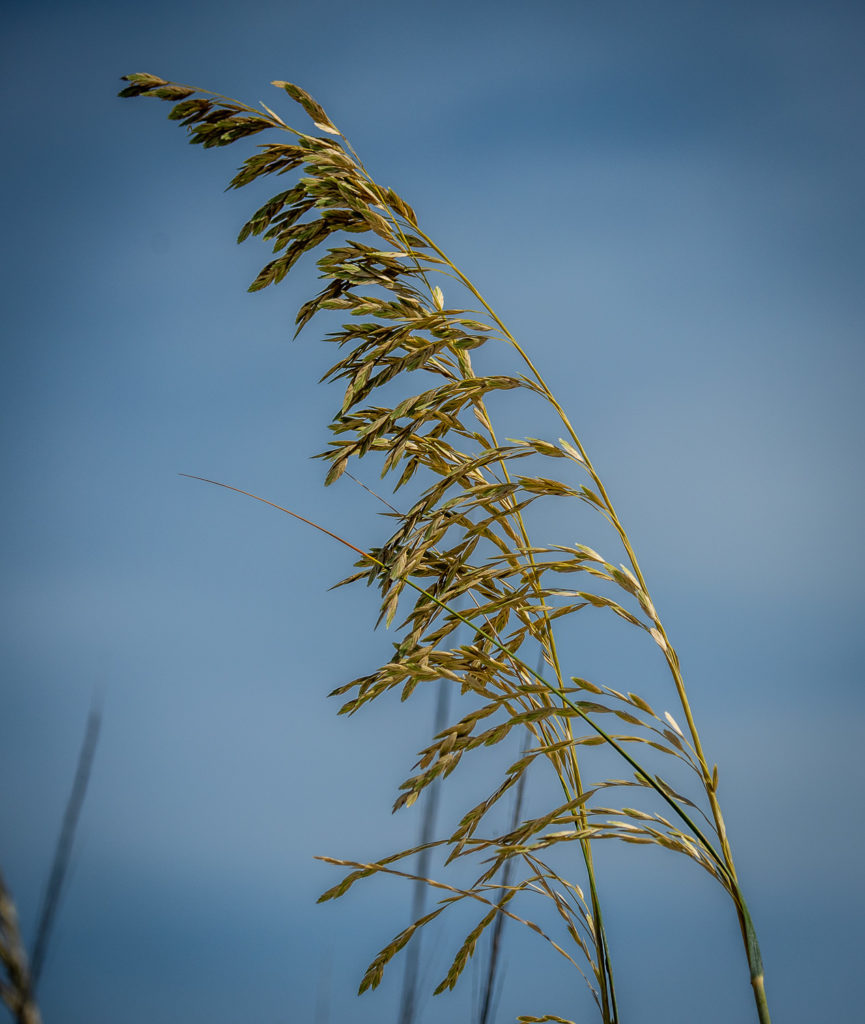Uniola paniculata
Uniola paniculata, also known as sea oats, seaside oats, araña, and arroz de costa,[1] is a tall subtropical grass that is an important component of coastal sand dune and beach plant communities in the southeastern United States, eastern Mexico and some Caribbean islands. Its large seed heads that turn golden brown in late summer give the plant its common name. Its tall leaves trap wind-blown sand and promote sand dune growth, while its deep roots and extensive rhizomes act to stabilize them, so the plant helps protect beaches and property from damage due to high winds, storm surges and tides. It also provides food and habitat for birds, small animals and insects.[1]
Description

Uniola paniculata is a tall, erect perennial grass that can grow to 1 to 2 m (3.3 to 6.6 ft) in height. Its long, thin leaves reach lengths of 20 to 40 cm (8 to 15.5 in) and are about 0.6 cm (0.24 in) in width, tapering to a pointed apex. The plant produces inflorescences of flat spikelets, each of which contains 10 to 12 wind-pollinated florets.[1] These ripen to golden brown infructescences or seed heads in late summer. The seeds are dispersed by wind and can be carried long distances by storms and ocean currents, but reproduction commonly occurs vegetatively by forming buds around stem bases.[2]
The plant forms dense surface roots and penetrating deep roots that are colonized by beneficial organisms such as mycorrhizal fungi. Rhizomes are elongate and produce extensive lateral growth. They root readily when buried in sand.[2]
Uniola paniculata uses a C4 pathway for carbon fixation.[3]
Distribution and habitat
Uniola paniculata is found on beach fronts and barrier islands along the Atlantic Coast from New Jersey[4][5][6] to Florida, and the Gulf Coast from Florida to Tabasco, Mexico. The range of Uniola paniculata along the US Atlantic coastline is expanding northward.[4][6] It also occurs in the Bahamas and northwestern Cuba. It grows primarily on foredunes and dune crests. It is uncommon in swales between dunes where salt spray is limited, and it is rarely found inland.[1][2]
Growing conditions

Due to the harsh conditions in which it grows, U. paniculata has little competition from other plants. It is heat tolerant and highly resistant to drought, salinity and brief inundation by sea water. It grows in loose sand rather than finer-grained silty or clay-rich soils and does not tolerate water-logging.[7] The plants tend to trap blowing sand, and burial of the plant base by sand stimulates growth and helps the plant spread by tacking down the rhizomes.[8]
Uniola paniculata is adversely affected by urban encroachment. Treated and untreated sewage, urban runoff and pollution from marinas all impact the plant. Off-road vehicles and foot traffic damage the plants, disrupt their roots and compact the sand. Loss of the plants leads to erosion and loss of protective dunes.[2]
Uses
Sea oats are well suited to saline environments, and as such, are important to barrier island ecology and are often used in sand stabilization projects because their long root structure firmly holds loose sand. For example, in Fort Lauderdale, Florida, colonies of sea oats have been planted at several beaches. The oats are a crucial component of the area's hurricane defense strategy and have helped to stave off damage from tropical storms. The sea oat colonies and nascent dune structure they support are expected to flourish.[9]
Legal protection
Sea oats are a protected grass in several states along the southeastern Atlantic coast. Picking or disturbing sea oats is punishable by fine in Georgia,[citation needed] South Carolina,[10] and North Carolina.[11] Florida by law also prohibits interfering with sea oats and protects nurserymen that grow sea oats.[12]
Wildlife habitat
Seeds of U. paniculata provide food for red-winged blackbirds, sparrows and other songbirds, as well as marsh rabbits and mice.[2]
References
- ^ a b c d Hazell, J., Brown, S.H. and Cooprider, K., Univ. of Florida, IFAS Extension, Lee County, Southwest Florida. "Uniola paniculata" (PDF). Archived from the original (PDF) on 2017-06-30. Retrieved 2014-11-28.
{{cite web}}: CS1 maint: multiple names: authors list (link) - ^ a b c d e K. Hill, Smithsonian Marine Station at Fort Pierce (2001). "Uniola paniculata". Retrieved 2014-11-28.
- ^ Lonard, Robert (2011). "Biological Flora of Coastal Dunes and wetlands: Uniola paniculata L". Journal of Coastal Research. 27: 984–993. doi:10.2112/JCOASTRES-D-10-00167.1. S2CID 129463689.
- ^ a b Goldstein, Evan B.; Mullins, Elsemarie V.; Moore, Laura J.; Biel, Reuben G.; Brown, Joseph K.; Hacker, Sally D.; Jay, Katya R.; Mostow, Rebecca S.; Ruggiero, Peter (2018-06-08). "Literature-based latitudinal distribution and possible range shifts of two US east coast dune grass species (Uniola paniculata and Ammophila breviligulata)". PeerJ. 6: e4932. doi:10.7717/peerj.4932. ISSN 2167-8359. PMC 5996817. PMID 29900075.
- ^ "US East Coast Dune Grass Literature Map". ebgoldstein.github.io. Retrieved 2018-06-08.
- ^ a b Goldstein, Evan; Mullins, Elsemarie; Moore, Laura; Biel, Reuben; Brown, Joseph; Hacker, Sally; Jay, Katya; Mostow, Rebecca; Ruggiero, Peter; Zinnert, Julie (2018). "Data Portal - Data Package Summary | Long Term Ecological Research Network (LTER)" (Data Set). Environmental Data Initiative. doi:10.6073/pasta/bdbe9a609e0508fdb7e39bc41f75bf6f.
{{cite journal}}: Cite journal requires|journal=(help) - ^ Hester, Mark W.; Mendelssohn, Irving A. (1989-03-01). "Water relations and growth responses of Uniola paniculata (sea oats) to soil moisture and water-table depth". Oecologia. 78 (3): 289–296. Bibcode:1989Oecol..78..289H. doi:10.1007/BF00379100. ISSN 0029-8549. PMID 28312572. S2CID 11101254.
- ^ R.A. Shadow, USDA Natural Resources Conservation Service, East Texas Plant Materials Center, Nacogdoches, TX. "Plant Fact Sheet for Sea Oats (Uniola paniculata L)" (PDF). Retrieved 2014-11-28.
{{cite web}}: CS1 maint: multiple names: authors list (link) - ^ South Florida Sun Sentinel. "Sea Oats". Archived from the original on May 4, 2013. Retrieved 2014-11-30.
- ^ "SC Code § 16-11-590 (2013)". Retrieved 27 September 2014.
- ^ "NCGS § 14-129.2". Retrieved 4 April 2013.
- ^ "Chapter 161 Section 242 - 2011 Florida Statutes". Retrieved 30 October 2017.
